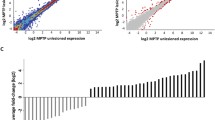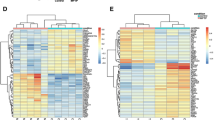Abstract
The present study was undertaken to investigate the gene expression patterns of the striatum of control and maneb + paraquat-induced Parkinson’s disease (PD) phenotype in mouse to identify the differentially expressed transcripts. The animals were treated with and without maneb (30 mg/kg, i.p.) + paraquat (10 mg/kg, i.p.), twice a week, for 3, 6, and 9 weeks. The RNA was isolated from control and treated mouse striatum and reverse transcribed, and equal quantities of labeled cDNA were mixed and hybridized with mouse 15 k arrays. Comparative transcription patterns showed the time of exposure dependent alteration in the expression of several transcripts associated with various pathways. RT-PCR reconfirmed the differential expression of some energy metabolizing transcripts. The study provides maneb + paraquat-induced differential expression of many transcripts using high-density microarray approach. Few transcripts, which were previously not reported to be associated with neuronal degeneration, were also identified. The results obtained thus suggest that maneb + paraquat induce neurotoxicity in the striatum in a time of exposure dependent manner via multiple pathways and defective energy metabolism could play a critical role.




Similar content being viewed by others
References
Hornykiewicz, O. (1973) Parkinson’s disease: From brain homogenate to treatment. Federation Proceedings, 32, 183–190.
Marsden, C. D. (1990) Parkinson’s disease. Lancet, 335, 948–952.
Albin, R. L., Young, A. B., & Penney, J. B. (1989) The functional anatomy of basal ganglia disorders. Trends Neuroscience, 12, 366–375.
Mason, J. N., Kozall, L. B., & Neve, K. A. (2002) Regulation of dopamine D1 receptor trafficking by protein kinase A-dependent phosphorylation. Molecular Pharmacology, 61, 806–816.
Singh, M. P., Patel, S., Dikshit, M., & Gupta, Y. K. (2006) Contribution of genomics and proteomics in understanding the role of modifying factors in Parkinson’s disease. Indian Journal of Biochemistry Biophysics, 43, 69–81.
Gorell, J. M., Johnson, C. C., Rybicki, B. A., Peterson, E. L., & Richardson, R. J. (1998). The risk of Parkinson’s disease with exposure to pesticides, farming, well water, and rural living. Neurology, 50, 1346–1350.
Brown, T. P., Rumsby, P. C., Capleton, A. C., Rushton, L., & Levy, L. S. (2006) Pesticides and Parkinson’s disease-is there a link? Environmental Health Perspectives, 114, 156–164.
deRijk, M. C., Breteler, M. M., Graveland G. A., Ott, A., Grobbee, D. F., van der Meche, F. G., & Hofman, A. (1995) Prevalence of Parkinson’s disease in the elderly: The Rotterdam study. Neurology, 45, 2143–2146.
Lowe, J., McDermott, H., Landon, M., Mayer R. J., & Wilkinson, K. D. (1990) Ubiquitin carboxyl-terminal hydrolase (PGP 9.5) is selectively present in ubiquitinated inclusion bodies characteristic of human neurodegenerative diseases. Journal of Pathology, 161, 153–160.
Galter, D., Westerlund, M., Carmine, A., Lindqvist, E., Sydow, O., & Olson, L. (2006) LRRK2 expression linked to dopamine-innervated areas. Annals of Neurology, 59, 714–719.
Valente, E. M., Bentivoglio, A. R., Dixon, P. H., Ferraris, A., Ialongo, T., Frontali, M., Albanese, A., & Wood, N. W. (2001) Localization of a novel locus for autosomal recessive early-onset parkinsonism, PARK6, on human chromosome 1p35-p36. American Journal of Human Genetics, 68, 895–900.
Kitada, T., Asakawa, S., Hattori, N., Matsumine, H., Yamamura, Y., Minoshima, S., Yokochi, M., Mizuno, Y., & Shimizu, N. (1998) Mutations in the parkin gene cause autosomal recessive juvenile parkinsonism. Nature, 392, 605–608.
Spillantini, M. G., Schmidt, M. L., Lee, V. M., Trojanowski, J. Q., Jakes, R., & Goedert, M. (1997) Alpha-synuclein in Lewy bodies. Nature, 388, 839–840.
Bonifati, V., Rizzu, P., van Baren, M. J., Schaap, O., Breedveld, G. J., Krieger, E., Dekker, M. C., Squitieri, F., Ibanez, P., Joosse, M. van Dongen, J. W., Vanacore, N., van Swieten J. C., Brice, A., Meco, G., van Duijn, C. M., Oostra, B. A., & Heutink, P. (2003) Mutations in the DJ-1 gene associated with autosomal recessive early-onset parkinsonism. Science, 299, 256–259.
Patel, S., Singh, V., Kumar, A., Gupta, Y. K., & Singh, M. P. (2006) Status of antioxidant defense system and expression of toxicant responsive genes in striatum of maneb-and paraquat-induced Parkinson’s disease phenotype in mouse: Mechanism of neurodegeneration. Brain Research, 1081, 9–18.
Patel, S., Sinha, A., & Singh, M. P. (2007) Identification of differentially expressed proteins in striatum of maneb-and paraquat-induced Parkinson’s disease phenotype in mouse. Neurotoxicology and Teratology, 29, 578–585.
Schapira, A. H., Cooper, J. M., Dexter, D., Clark, J. B., Jenner, P., & Marsden, C. D. (1990) Mitochondrial complex I deficiency in Parkinson’s disease. Journal of Neurochemistry, 54, 823–827.
Langston, J. W., Ballard, P. A., Tetrud, J. W., & Irwin, I. (1993) Chronic parkinsonism in humans due to a product of meperidine-analog synthesis. Science, 219, 979–980.
McCormack, A. L., Atienza, J. G., Johnston, L. C., Andersen, J. K., Vu, S., & Di Monte, D. A. (2005) Role of oxidative stress in paraquat-induced dopaminergic cell degeneration. Journal of Neurochemistry, 93, 1030–1037.
Thiruchelvam, M., Richfield, E. K., Baggs, R. B., Tank, A. W., & Cory-Slechta, D. A. (2000) The nigrostriatal dopaminergic system as a preferential target of repeated exposures to combined paraquat and maneb: Implications for Parkinson’s disease. Journal of Neuroscience, 20, 9207–9214.
Thiruchelvam, M., McCormack, A., Richfield, E. K., Baggs, R. B., Tank, A. W., Di Monte, D. A., & Cory-Slechta, D. A. (2003) Age-related irreversible progressive nigrostriatal dopaminergic neurotoxicity in the paraquat and maneb model of the Parkinson’s disease phenotype. European Journal of Neuroscience, 18, 589–600.
Cory-Slechta, D. A., Thiruchelvam, M., Barlow, B. K., & Richfield, E. K. (2005) Developmental pesticide models of the Parkinson disease phenotype. Environmental Health Perspectives, 113, 1263–1270.
Chomczynski, P. (1993) A reagent for the single-step simultaneous isolation of RNA, DNA and proteins from cell and tissue samples. Biotechniques, 15, 532–537.
Filipenko, M. L., Alekseyenko, O. V., Beilina, A. G., Kamynina, T. P., & Kudryavtseva, N. N. (2001) Increase of tyrosine hydroxylase and dopamine transporter mRNA levels in ventral tegmental area of male mice under influence of repeated aggression experience. Molecular Brain Research, 96, 77–81.
Herzog, B., Cardenas, J., Hall, R. K., Villena, J. A., Budge, P. J., Giguere, V., Granner, D. K., & Kralli, A. (2006) Estrogen-related receptor-α is a repressor of phosphoenolpyruvate carboxy kinase gene transcription. Journal of Biological Chemistry, 281, 99–106.
Dentin, R., Pegorier, J., Benhamed, F., Foufelle, F., Ferre, P., Fauveau, V., Magnuson, M. A., Girard, J., & Postic, C. (2004) Hepatic glucokinase is required for the synergistic action of ChREBP and SREBP-1c on glycolytic and lipogenic gene expression. Journal of Biological Chemistry, 279, 20314–20326.
Shen, X., Zheng, S., Thongboonkerd, V., Xu, M., Pierce, W. M. Jr., Klein, J. B., & Epstein, P. N. (2004) Cardiac mitochondrial damage and biogenesis in a chronic model of type I diabetes. American Journal of Physiology Endocrinology and Metabolism, 287, E896–E905.
Grange, R. W., Meeson, A., Chin, E., Lau, K. S., Stull, J. T., Shelton, J. M., Williams, R. S., & Garry, D. J. (2001) Functional and molecular adaptations in skeletal muscle of myglobin-mutant mice. American Journal of Physiology Cell Physiology, 281, C1487–1494.
Fan, Q., Ding, J., Zhang, J., Guan, N., & Deng, J. (2004) Effect of the knockdown of podocin mRNA on nephrin and α-actinin in mouse podocyte. Experimental Biology and Medicine, 229, 964–970.
Thiruchelvam, M., Richfield, E. K., Goodman, B. M., Baggs, R. B., & Cory-Slechta, D. A. (2002) Developmental exposure to the pesticides paraquat and maneb and the Parkinson’s disease phenotype. Neurotoxicology, 23, 621–633.
Napolitano, M., Centonze, D., Calce, A., Picconi, B., Spiezia, S., Gulino, A., Bernardi, G., & Calabresi, P. (2002) Experimental parkinsonism modulates multiple genes involved in the transduction of dopaminergic signals in the striatum. Neurobiology of Diseases, 10, 387–395.
Duke, D. C., Moran, L. B., Kalaitzakis, M. E., Deprez, M., Dexter, D. T., Pearce, R. K., & Graeber, M. B. (2006) Transcriptome analysis reveals link between proteosomal and mitochondrial pathways in Parkinson’s disease. Neurogenetics, 7, 139–148.
Castello, P. R., Drechsel, D. A., & Patel, M. (2007) Mitochondria are a major source of paraquat induced reactive oxygen species production in the brain. Journal of Biological Chemistry, 282, 14186–14193.
Stack, E. C., & Ferrante, R. J. (2007) Huntington’s disease: Progress and potential in the field. Expert Opinion on Investigational Drugs, 16, 1933–53.
Klein, C., & Schlossmacher, M. G. (2006) The genetics of Parkinson disease: Implications for neurological care. Nature Clinical Practice Neurology, 2, 136–146.
Choi, P., Ostrerova-Golts, N., Sparkman, D., Cochran, E., Lee, J. M., & Wolozin, B. (2000). Parkin is metabolized by the ubiquitin/proteosome system. Neuroreport, 11, 2635–2638.
Acknowledgments
The authors sincerely thank the Council of Scientific and Industrial Research (CSIR), New Delhi, and University Grant Commission, New Delhi, for providing research fellowship to Suman Patel and Seema Singh, respectively. The authors also thank Department of Biotechnology (DBT), India, for providing financial support for the study. The ITRC communication number of this manuscript is 2580.
Author information
Authors and Affiliations
Corresponding author
Rights and permissions
About this article
Cite this article
Patel, S., Singh, K., Singh, S. et al. Gene Expression Profiles of Mouse Striatum in Control and Maneb + Paraquat-induced Parkinson’s Disease Phenotype: Validation of Differentially Expressed Energy Metabolizing Transcripts. Mol Biotechnol 40, 59–68 (2008). https://doi.org/10.1007/s12033-008-9060-9
Received:
Accepted:
Published:
Issue Date:
DOI: https://doi.org/10.1007/s12033-008-9060-9




